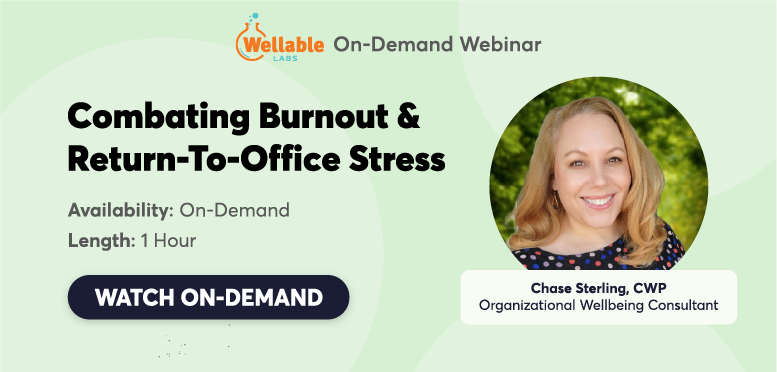Prolonged stress can make it more difficult for individuals to approach their daily activities with energy, positivity, and focus. Once enjoyable hobbies may temporarily lose their appeal, and household responsibilities can become more cognitively taxing than usual.
Over a year and a half into the pandemic, chronic workplace- or employment-related stress has become especially prevalent. Many individuals are struggling with job loss or decreased job security. Those who have kept their jobs are grappling with dwindling work-life balance as remote work continues to blur the once clear line between the times when employees are expected to be productive and when the workday is over.
As a result, an unusually high number of employees are experiencing what is known as “occupational burnout,” which, according to the World Health Organization (WHO) is characterized by “by feelings of energy depletion or exhaustion, increased mental distance from one’s job, or feelings of negativism or cynicism related to one’s job, and reduced professional efficacy.” In Indeed’s recent study on workplace burnout, 52% of respondents reported feeling burned out and 67% claimed that the feeling has worsened over the past year.
As stewards of employee wellness, engagement, and productivity, employers must closely monitor and actively combat the presence of burnout in their organizations. To do so effectively, employers should start by understanding occupational burnout’s common causes. These are discussed in detail below.
The Causes Of Occupational Burnout
In their article Understanding The Burnout Experience: Recent Research And Its Implications For Psychiatry, Christina Maslach and Michael Leiter identify six key factors that contribute to workplace burnout. These include:
- Workload: Generally, the longer one work, the less energy they have left over to continue working. As workloads increase, employees have little time to recover and restore their energy levels. To continue working under these circumstances, workers must exert more effort with no end in sight, causing an increase in stress levels and a decrease in cognitive efficiency.
- Lack of Control: Employees desire professional autonomy. They want to have a say in where and when they work and more importantly, they want their employers to trust them to make key decisions without being micromanaged in the process. With increased control, employees feel valued by their companies and confident that they can sculpt their schedules in a way that allows them to work most efficiently.
- Rewards: People like to receive recognition for a job well done. Without positive feedback, employees are likely to feel as though their work is not adequate and that they are not valued as employees. Eventually, this leads to feelings of inefficacy, which causes stress and ultimately burnout.
- Community: The relationships that employees have with their colleagues has a significant impact on their stress levels and, therefore, on their tendency to become burnt out. When workers perceive significant levels of social support within the workplace, they are better able to withstand other stressors that come their way. On the other hand, when there is a lack of trust and consistent conflict, workplace relationships can exacerbate stress and burnout.
- Fairness: It is difficult to conjure up a desire to help someone who you feel has been treating you unfairly. This applies just as much to organizations as it does to ordinary interpersonal relationships. Employees who feel that they are being treated unfairly, whether it be in pay, treatment, or work assignments, are unlikely to feel positively towards their organization or to fully engage with their assignments.
- Values: Workers often apply for jobs because they feel that there is a match between what they value and what the company values. When this match is confirmed via their on-the-job experiences, workers feel fulfilled and are highly motivated to help their company achieve its missions. If an employee comes to realize that their company’s values have changed or were misrepresented from the get-go, they are likely to feel cynical towards their workplace and have a difficult time enjoying their work or cultivating a significant degree of engagement with it
Takeaway
With the common factors associated with burnout in mind, employers can begin to address any potential burnout in their organizations. First, they must determine how prevalent burnout is in their company. One of the best ways to accomplish this is through anonymous surveys that assess the degree to which workers feel that the above-mentioned risk factors are present in their jobs.
With workers’ responses in hand, employers can engage in prevention and treatment. Darcy Gruttadaro, the director of the American Psychiatric Association Foundation’s Center for Workplace Mental Health, notes in her interview with ABC news that change begins with leadership as their actions set the tone and expectations for everyone else in the organization. When it comes to combatting excessive workloads or long work hours, Gruttardo suggests that leaders demonstrate good behavior by “not sending emails very late at night” and “not sending weekend emails all the time.” This will help employees feel more comfortable clocking out at “normal” times.
Employers can address other issues by modeling good behavior and fixing the problems more directly. Workers who feel that they are not being adequately rewarded can be swiftly assuaged with praise during weekly meetings or even a raise. Similarly, leaders can respond to a perceived lack of control by trusting their employees with the levels of control they are asking for.
While burnout is becoming more prevalent and presents significant problems for productivity, engagement, and workplace loyalty, leaders have the tools to address it. By surveying their workforces to assess the problem, employers can zero in on the causes of burnout in their organizations. With a focus on these issues, leaders can combat them by adhering to anti-burnout norms (e.g., not overloading themselves with work) and by directly intervening to nullify other sources of stress (e.g., a lack of rewards of unfair treatment).













